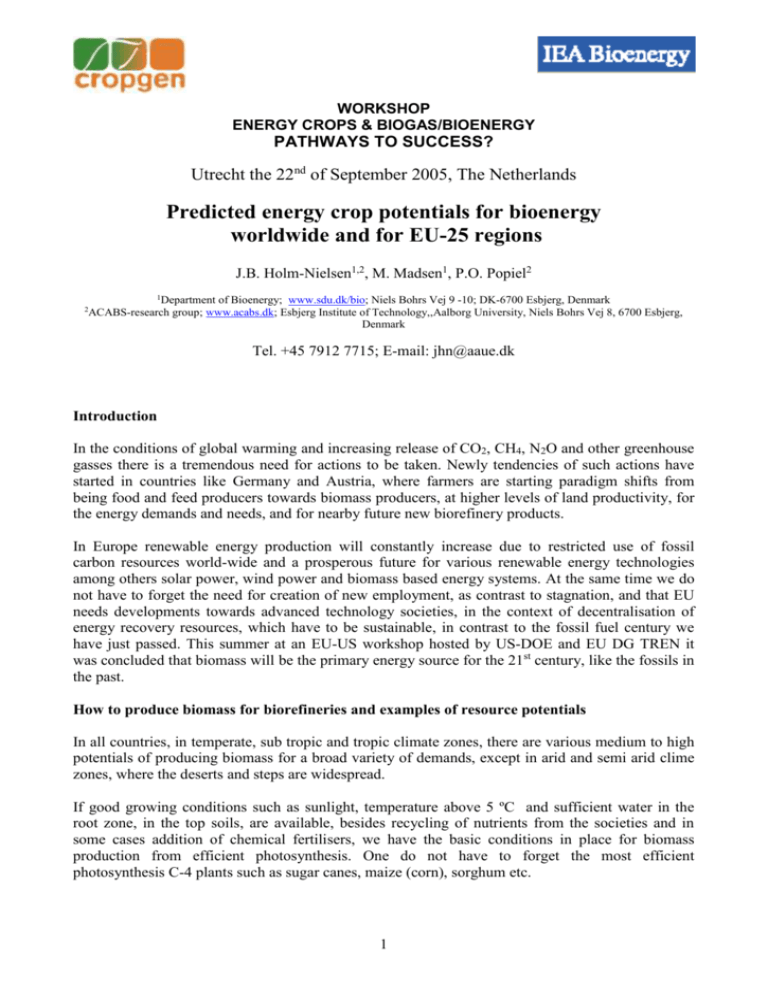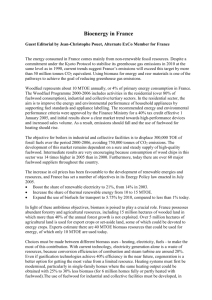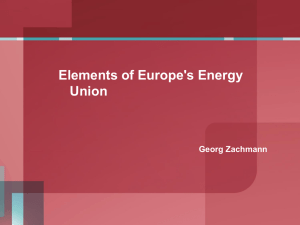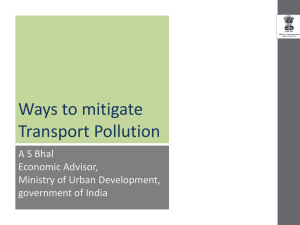predicted energy crop potentials for biogas – worldwide, regions
advertisement

WORKSHOP ENERGY CROPS & BIOGAS/BIOENERGY PATHWAYS TO SUCCESS? Utrecht the 22nd of September 2005, The Netherlands Predicted energy crop potentials for bioenergy worldwide and for EU-25 regions J.B. Holm-Nielsen1,2, M. Madsen1, P.O. Popiel2 1Department of Bioenergy; www.sdu.dk/bio; Niels Bohrs Vej 9 -10; DK-6700 Esbjerg, Denmark ACABS-research group; www.acabs.dk; Esbjerg Institute of Technology,,Aalborg University, Niels Bohrs Vej 8, 6700 Esbjerg, Denmark 2 Tel. +45 7912 7715; E-mail: jhn@aaue.dk Introduction In the conditions of global warming and increasing release of CO2, CH4, N2O and other greenhouse gasses there is a tremendous need for actions to be taken. Newly tendencies of such actions have started in countries like Germany and Austria, where farmers are starting paradigm shifts from being food and feed producers towards biomass producers, at higher levels of land productivity, for the energy demands and needs, and for nearby future new biorefinery products. In Europe renewable energy production will constantly increase due to restricted use of fossil carbon resources world-wide and a prosperous future for various renewable energy technologies among others solar power, wind power and biomass based energy systems. At the same time we do not have to forget the need for creation of new employment, as contrast to stagnation, and that EU needs developments towards advanced technology societies, in the context of decentralisation of energy recovery resources, which have to be sustainable, in contrast to the fossil fuel century we have just passed. This summer at an EU-US workshop hosted by US-DOE and EU DG TREN it was concluded that biomass will be the primary energy source for the 21st century, like the fossils in the past. How to produce biomass for biorefineries and examples of resource potentials In all countries, in temperate, sub tropic and tropic climate zones, there are various medium to high potentials of producing biomass for a broad variety of demands, except in arid and semi arid clime zones, where the deserts and steps are widespread. If good growing conditions such as sunlight, temperature above 5 ºC and sufficient water in the root zone, in the top soils, are available, besides recycling of nutrients from the societies and in some cases addition of chemical fertilisers, we have the basic conditions in place for biomass production from efficient photosynthesis. One do not have to forget the most efficient photosynthesis C-4 plants such as sugar canes, maize (corn), sorghum etc. 1 In table 1 and 2 a case example for Denmark is given. This is a picture of potentials and possibilities for the future European paradigm shift towards biomass production for energy and new biomass based products. In earlier decades all efforts were concentrated on production of food and for feeding a growing population and an rising animal production, by all means increasing living standards. At the same time all energy demands and supplies were fulfilled by fossil carbon sources. Have we reached a maturity level, or is it even above in some industrialized countries? In table 1 an example of how the entire area of Denmark is utilized, including future possible changes, is presented. The survey balances, interests of agricultural, forestry production, nature conservation as well as environmental interests. Table 1. Utilization of the entire area of Denmark and probable future changes [10] Area usage; units in 1.000 ha Arable land Fallow / brackish Non-food, single/mutiannual Permanent grassland Agriculture total Forestry / woods Fences, ditches, field roads Heath, dune, bog Lakes, streams Buildings in rural areas Cities, roads, holiday cottages Total area 1995 2.290 220 30 200 2.740 500 113 200 65 230 460 4.308 2005 2.035 150 150 325 2.660 550 123 205 75 230 465 4.308 2025 1.770 0 300 450 2.520 650 133 210 95 230 470 4.308 From 2005 to 2025 the tendency will be that there will be no more fallow land. Part of the arable land resources, in the range of 10-20-30 percent of the categories of arable land, fallow and nonfood areas, will in the next two decades be utilized for energy farming, cultivation systems aiming at maximum energy storage in organic biomass with acceptable quantities of medium to high net yielding crops per hectare. These kinds of crops will be grown and handled much more rational than traditional food crops and as cheap as possible at the input side, to gain maximum favorable energy output and balance. Table 2 depicts Danish gross energy consumption of present years compared with a survey of future scenarios of either light green or dark green scenarios. One scenario features how to run the society without any kind of fossil fuels. In these scenarios highly efficient utilisation of energy sources by all means as well as energy savings at all levels are included. Table 2 displays the energy net consumption derived from biomass in the span of 119 – 137 PJ of biomass in the year 2030. In combination with 300.000 – 500.000 ha arable land dedicated for energy and biorefinery farming, in the long term it will be more than realistic to reach between 120 – 140 PJ biomass energy production, or even higher, under Danish conditions. This means that such a society can be organized and managed on conditions of between 50 – 100 pct. renewable energy sources. At the same time the dependencies of fossil carbon sources will be minimized throughout the years, as it can be seen in the statistical data from year 1992 and year 2003, where the coal dependency had been decreasing nearly to the half of the consumption in 1992. 2 Table 2. Comparison of Danish gross energy consumption with two future scenarios [11] Unit: PJ per year 1992 *) 2003 *) Oil 348 342 Coal 324 176 Natural gas 95 191 Biomass 54 88 Biogas <1 4 Liquid biofuels 2 Solar heating <1 <1 PV (Solar cells) Windpower 3 20 Net power import 13 - 31 Total 776 793 * ) Figures from the Danish Energy Authority 2030 Light green scenario 246 22 146 119 4 4 32 0 573 2030 Dark green Scenario 0 0 0 6-7 (137) 45 (90) 22 (47) 40 25 90 0 229 (429) The future will be much more diversified, where regenerative carbon sources will be based on biomass sources of various kind, naturally adapted to the different growing conditions in the changing climate conditions and with a broader utilisation of biomasses for food, feed, fibres, fuels, fertilisers etc, after passing different, pre-treatment technologies before biorefining. Table 3 contents registered data of total area of land use for 25 European Countries (EU-25). Areas of specific interests for biomass production conditions are the columns of arable land, and partly forest areas and permanent grassland areas. The fallow areas will quite soon be integrated in arable land or non-food areas. Table3.Data of total area and areas of interest for biomass production for each member of EU25[12] Unit: 1 000 ha Country Austria Belgium Cyprus Czech Republic Denmark Estonia Finland France Germany Greece Hungary Ireland Italy Latvia Lithuania Luxembourg Malta Netherlands Poland Portugal Slovakia Slovenia Spain Sweden United Kingdom Total area 8 387 3 053 925 7 887 4 310 4 523 33 815 54 909 35 703 13 196 9 303 7 027 30 134 6 459 6 530 259 32 4 153 31 269 9 191 4 903 2 027 50 532 41 034 24 291 393 849 Agriculture area 3 374 1 393 137 3 652 2 676 698 2 236 29 556 16 974 3 897 5 867 4 372 15 546 1 596 2 903 128 10 1 949 16 899 3 846 2 236 505 25 289 3 140 16 352 165 229 Arable land (% of total area) 1 379 833 87 2 767 2 479 613 2 204 18 275 11 791 2 211 4 516 1 177 8 384 973 1 639 62 9 1 011 13 067 1 589 1 377 168 13 081 2 680 6 397 98 765 16 27 9 35 58 14 7 33 33 17 49 17 28 15 25 24 27 24 42 17 28 8 26 7 26 25 Forest (% of total area) 3 260 607 N/A 2 643 473 2 251 22 487 15 403 10 531 N/A 1 772 N/A 6 856 2 862 1 997 89 N/A 353 9 090 3 465 2 002 1 283 16 493 22 323 N/A 126 239 39 20 N/A 34 11 50 66 28 29 N/A 19 N/A 23 44 31 34 N/A 9 29 38 41 63 33 54 N/A 32 Permanent grass (% of total area) 1 917 536 1 839 186 67 27 9 972 4 970 146 1 063 3 193 4 379 610 1 203 65 N/A 892 3 562 1 468 799 307 7 125 482 9 906 53 715 Summary, EU-25 J.B. Holm-Nielsen, P.O. Popiel & M. Madsen, Department of Bioenergy, SDU, Denmark (2005) 3 23 18 <1 11 4 1 <1 18 14 1 11 45 15 9 18 25 N/A 21 11 16 16 15 14 1 41 14 Fallow 106 28 7 83 205 25 211 1 280 835 441 195 18 617 94 193 2 0 30 2 302 539 4 1 3 195 269 33 10 710 From table 3 can be surveyed the biomass potentials for biorefinery purposes. E.g. Germany, a large central European country, has 11.8 mil. ha of arable land. Future biomass potentials in Germany for energy crops are stipulated to be up to 2.0 mil. ha or 17 pct. of the arable land in medium to long terms. From this area can be derived and produced a corresponding energy production of 40 pct. Of the fuels needed for transportation or 20 pct. of the primary energy net consumption. As an example: if only 10 pct. of arable land is used for energy production at poorly developed yield condition, there will be 1778 PJ production for the whole EU-25. That would be more than the double of the demand for the entire Danish energy consumption for a whole year (which is +/800PJ). In the tables 3a & 3b scenarios of area utilisation of arable land from 25 EU countries for energy crop production and the potentials of energy recovery form these areas expressed as mill. tons of oil equivalent at 3 different crop yielding levels are shown. Table 3a. Scenarios of area utilization of arable land for EU-25 in PJ Area used for 10 % of arable 20 % of arable 30 % of arable energy prod. land in EU-25 land in EU-25 land in EU-25 Yield pr. ha 10 t TS pr. ha 1 778 PJ 3 556 PJ 5 333 PJ 20 t TS pr. ha 3 556 PJ 7 111 PJ 10 667 PJ 30 t TS pr. ha 5 333 PJ 10 667 PJ 16 000 PJ * 1 PJ equals 1015 J Note: The total area of the arable land in the EU-25 is assumed to be in the order of 98.765.000 ha (according to Eurostat figures 2002) Table 3b. Scenarios of area utilization of arable land for EU-25 in MTOE Area used for 10 % of arable 20 % of arable 30 % of arable energy prod. land in EU-25 land in EU-25 land in EU-25 Yield pr. ha 10 t TS pr. ha 40 MTOE 79 MTOE 119 MTOE 20 t TS pr. ha 79 MTOE 159 MTOE 238 MTOE 30 t TS pr. ha 119 MTOE 238 MTOE 357 MTOE * MTOE: Million Ton Oil Equivalent. 1 MTOE equals 44.8 PJ J.B. Holm-Nielsen, P.O. Popiel & M. Madsen, Department of Bioenergy, SDU, 2005 Table 4 presents total and agriculture area as well as arable land, permanent crops, pasture, and forests and woodland expressed in hectares and as a percentage of the total area. The table contains data for the whole world, continents and the most attractive countries for biomass production. 4 Table 4. Total area and areas important for biomass production in the world, subdivided in continents and the most interesting countries [13] Unit: 1 000ha Total area Agriculture area Arable land Permanent crops (% of total area) (% of total area) Permanent pasture (% of total area) 13 427 880 5 012 266 1 404 130 10 136 578 1 3 471 729 World 3 030 974 1 110 974 184 905 6 25 792 1 900 448 Africa 238 174 40 065 7 665 3 600 0 31 800 Algeria 47 544 9 160 5 960 13 1 200 3 2 000 Cameroon 110 430 30 671 9 936 9 735 1 20 000 Ethiopia 44 655 30 283 8 396 19 887 2 21 000 Morocco 92 337 72 200 30 200 33 2 800 3 39 200 Nigeria 121 909 99 640 14 753 12 959 1 83 928 South Africa 250 581 133 833 16 233 6 420 0 117 180 Sudan 3 186 692 1 683 886 511 701 16 61 686 2 1 110 499 Asia 959 805 553 957 142 621 15 11 335 1 400 001 China 328 726 181 177 161 715 49 8 400 3 11 062 India 190 457 44 877 20 500 11 13 200 7 11 177 Indonesia 37 789 5 190 4 418 12 344 1 428 Japan 272 490 206 769 21 535 8 136 0 185 098 Kazakhstan 79 610 27 120 21 448 27 672 1 5 000 Pakistan 51 312 20 167 15 867 31 3 500 7 800 Thailand 77 482 41 690 25 938 33 2 585 3 13 167 Turkey 2 297 649 486 858 287 221 13 16 772 1 182 865 Europe 20 760 8 924 5 606 27 124 1 3 194 Belarus 11 099 5 325 3 355 30 228 2 1 742 Bulgaria 23 839 14 837 9 398 39 501 2 4 938 Romania 1 707 540 216 651 123 465 7 1 835 0 91 351 Russia 10 217 5 586 3 397 33 327 3 1 862 Serbia & Mont. 60 370 41 396 32 544 54 913 2 7 939 Ukraine North& Central 2 272 494 621 403 257 273 11 15 094 1 349 036 America 997 061 67 505 45 660 5 6 455 1 15 390 Canada 11 086 6 655 2 668 24 1 120 10 2 867 Cuba 195 820 107 300 24 800 13 2 500 1 80 000 Mexico 13 000 6 976 1 925 15 236 2 4 815 Nicaragua 962 909 411 863 176 018 18 2 050 0 233 795 USA 1 783 361 642 482 112 642 6 13 952 1 515 888 South America 278 040 177 000 33 700 12 1 300 0 142 000 Argentina 109 858 36 937 2 900 3 206 0 33 831 Bolivia 851 488 263 580 58 980 7 7 600 1 197 000 Brazil 40 675 24 815 3 020 7 95 0 21 700 Paraguay 128 522 31 410 3 700 3 610 0 27 100 Peru 856 440 466 663 50 388 6 3 282 0 412 993 Oceania 774 122 447 000 48 300 6 300 0 398 400 Australia 27 053 17 235 1 500 6 1 872 7 13 863 New Zealand J.B. Holm-Nielsen, P.O. Popiel & M. Madsen, Department of Bioenergy, SDU, Denmark (2005) Data from 2002 (forests and woodland – 1994) 5 Forests and woodland (% of total area) 26 30 13 4 18 47 42 69 47 35 42 3 6 1 68 6 2 17 8 15 16 21 5 18 13 4 172 435 712 676 3 950 35 900 13 300 8 970 14 300 8 200 42 000 556 747 130 518 68 500 111 774 24 621 9 600 3 480 14 500 20 199 947 276 7 200 3 348 6 680 765 912 1 769 9 239 31 24 2 76 12 20 15 7 17 17 14 21 59 65 4 4 28 26 41 35 30 28 45 17 15 15 823 914 36 2 26 41 37 24 29 51 31 23 53 21 48 51 51 453 330 2 608 48 700 3 200 295 990 931 570 50 900 58 000 555 000 12 850 84 800 200 252 145 000 7 667 45 24 25 25 31 52 18 53 65 32 66 23 19 28 As expected, from the above table it can be easy noticed that the highest percentage of arable land is in Asia, and than in Europe and North & Central America. Moreover, the arable land areas in Asia are over 1/3 of the total world arable land. Therefore, countries like China or India are together covering around 300 000 000 ha of arable land. These countries might become the most vital biomass - and consequently bioenergy - producers. In Africa, although the priority is food production, the need of energy is necessary as well. Biomass agriculture might significantly positively influence on the national economies of developing countries, especially in tropical and sub-tropical regions: countries like Cameroon or Nigeria in which area of arable land as well as woodland is main part of the country. Furthermore, the South Africa, which is the only one African country ranked as a developed country [13], might be also interested in energy crop production due to its high energy requirements. In Europe, apart from EU countries, Ukraine might play a significant role in biomass production; Russia with huge potential for biomass production and of course its vast forestry area could play a major role in energy crops, forestry/agriculture industry. USA and Brazil are already gaining profits from bioethanol production from maize and sugar cane, respectively. Other American countries, like Canada or Argentina with significant agriculture areas, might join them in the near future, with suitable well adopted crop types. Tables 4a and 4b consist of calculated energy recovery expresses in PJ and TOE, respectively. The values for the whole world and different continents are computed for three diverse crop yielding levels and three different percentage of assumed area for energy production. Table 4a. Scenarios of area utilization of arable land at the world and particular continents for energy crop production expressed in PJ Area used for energy 10% of arable 20% of arable production land land Yield pr. ha 10 tTS/ha 25 274 PJ 50 549 PJ 20 tTS/ha 50 549 PJ 101 097 PJ World 30 tTS/ha 75 823 PJ 151 646 PJ 10 tTS/ha 3 328 PJ 6 657 PJ Africa 20 tTS/ha 6 657 PJ 13 313 PJ 30 tTS/ha 9 985 PJ 19 970 PJ 10 tTS/ha 9 211 PJ 18 421 PJ Asia 20 tTS/ha 18 421 PJ 36 842 PJ 30 tTS/ha 27 632 PJ 55 264 PJ 10 tTS/ha 5 170 PJ 10 340 PJ Europe 20 tTS/ha 10 340 PJ 20 680 PJ 30 tTS/ha 15 510 PJ 31 020 PJ 10 tTS/ha 4 631 PJ 9 262 PJ North & Central 20 tTS/ha 9 262 PJ 18 524 PJ America 30 tTS/ha 13 893 PJ 27 785 PJ 10 tTS/ha 2 028 PJ 4 055 PJ South America 20 tTS/ha 4 055 PJ 8 110 PJ 30 tTS/ha 6 083 PJ 12 165 PJ 10 tTS/ha 907 PJ 1 814 PJ Oceania 20 tTS/ha 1 814 PJ 3 628 PJ 30 tTS/ha 2 721 PJ 5 442 PJ Lower combustion energy value is 18 MJ per kg TS; 1 PJ equals 1015 J 6 30% of arable land 75 823 PJ 151 646 PJ 227 469 PJ 9 985 PJ 19 970 PJ 29 955 PJ 27 632 PJ 55 264 PJ 82 896 PJ 15 510 PJ 31 020 PJ 46 530 PJ 13 893 PJ 27 785 PJ 41 678 PJ 6 083 PJ 12 165 PJ 18 248 PJ 2 721 PJ 5 442 PJ 8 163 PJ Table 4b. Scenarios of area utilization of arable land at the world and particular continents for energy crop production expressed in MTOE World Africa Asia Europe North & Central America South America Oceania Area used for energy production Yield pr. ha 10 tTS/ha 20 tTS/ha 30 tTS/ha 10 tTS/ha 20 tTS/ha 30 tTS/ha 10 tTS/ha 20 tTS/ha 30 tTS/ha 10 tTS/ha 20 tTS/ha 30 tTS/ha 10 tTS/ha 20 tTS/ha 30 tTS/ha 10 tTS/ha 20 tTS/ha 30 tTS/ha 10 tTS/ha 20 tTS/ha 30 tTS/ha 10% of arable land 20% of arable land 30% of arable land 564 MTOE 1 128 MTOE 1 693 MTOE 74 MTOE 149 MTOE 223 MTOE 206 MTOE 411 MTOE 617 MTOE 115 MTOE 231 MTOE 346 MTOE 103 MTOE 207 MTOE 310 MTOE 45 MTOE 91 MTOE 136MTOE 20 MTOE 41 MTOE 61 MTOE 1 128 MTOE 2 257 MTOE 3 385 MTOE 149 MTOE 297 MTOE 446 MTOE 411 MTOE 822 MTOE 1 234 MTOE 231 MTOE 462 MTOE 692 MTOE 207 MTOE 414 MTOE 620 MTOE 91 MTOE 181 MTOE 272 MTOE 41 MTOE 81 MTOE 122 MTOE 1 693 MTOE 3 385 MTOE 5 077 MTOE 223 MTOE 446 MTOE 669 MTOE 617 MTOE 1 234 MTOE 1 850 MTOE 346 MTOE 692 MTOE 1 039 MTOE 310 MTOE 620 MTOE 930 MTOE 136 MTOE 272 MTOE 407 MTOE 61 MTOE 122 MTOE 182 MTOE 1 MTOE ~ 44.8 PJ J.B. Holm-Nielsen, P.O. Popiel & M. Madsen, Department of Bioenergy, SDU, Denmark (2005) In the coming 10 -20 years it will not be unrealistic to see an increasing utilisation of crops for energy and industrial purposes. Scenarios of 10 -20 -30 pct. of arable land shifting from food and feed towards energy farming will gradually occur. Another large European country, Ukraine is rapidly developing in the same direction like the EU countries. In such a large, fertile agricultural country it is stipulated that introduction of renewable energy sources will grow as fast as in many EU countries. In the table below it is depicted that biomass will cover nearly 50 pct. of the renewable energy resources in the long term future. Energy cropping will even increase this potential when energy crops are integrated in large scale biorefinery systems in Ukraine. 7 Table 5. Renewable energy sources (RES) in Ukraine; Calculations and predictions until 2030 [2] Technical potential 2001 Type Mln t % Mln t coal coal eqv eqv 15 23.8 0.01 Wind energy 2.0 3.2 N/A Photovoltaic 3.0 4.8 0.17 Small hydro 7.0 11.1 4.36 Big hydro 4.0 6.4 0.002 Solar heating 20 31.7 0.99 Biomass 12 19 0.004 Geothermal 63 100 5.54 Total 1 TOE =1.43 t coal eqv.; N/A: Not Available Heat and electricity production from RES 2010 Mln t coal eqv 0.22 0.001 0.15 4.8 0.12 1.66 0.034 6.99 % 0.2 N/A 3.1 78.7 0.04 17.9 0.1 100 % 3.2 0.02 2.2 68.6 1.7 23.8 0.5 100 2020 Mln t coal eqv 1.0 0.01 0.48 5.6 0.7 6.3 0.247 14.34 % 7.0 0.1 3.4 39 4.9 43.9 1.7 100 2030 Mln t coal eqv 2.15 0.03 0.65 6.53 1.28 10.13 0.83 21.6 % 10 0.1 3.0 30.2 5.9 46.9 3.8 100 Case example of plant breeding gene pool potentials exemplified by maize/corn crop varieties. The gen-pools are not yet developed for dedicated biomass production. For decades crop breeding was dedicated for specific tasks of optimal production yields for starch, vegetable oil, sugar, proteins and not for the total crop yield, including the interesting lignocelluloses complexes in steams and leaves and the entire crop biomass. A future perspective for biomass carbon capture includes the whole crop, with as effective and/or robust conversion into photosynthesis products, at as good rates as will be possible, due to various growing and climate conditions. Potentials are not yet very well developed in the plant breeding and cropping sectors of agriculture. Below is a plant breeding company example of new maize varieties. The breeding incentives for energy maize varieties include a. short-day genes, b. tolerance towards cold growing conditions in late varieties, c. nutrient/water efficiency. Commercial energy maize varieties, as an example, will be on the market in 2007. The figure below shows how to grow not 15-20 t of TS/ha, but with an increasing trend towards 30 t of TS/ha in the future (figure 1, 2). 8 Source: Dr. Ernst Kesten, KWS Saatgut AG, Einbeck, (D) Figure 1. Case example of plant breeding gene pool potentials for mazie crop [4] Source: Dr. Ernst Kesten, KWS Saatgut AG, Einbeck (D) Figure 2. Harvesting of maize crops [4] 9 Future perspectives for biomass utilisation in the energy and industrial sectors. At present the energy supply from biomass is around 45 +/- 10 EJ per year. Main uses consist on traditional way e.g. firing for cooking and heating. The modern technologies (e.g. production of liquid biofuels or electricity and heat – CHP) are approximated at 7EJ a year [6]. The potential to upgrade biomass for biofuels is evident, and can be converted in conventional used technologies, as example fermentation processes for fuels to the transportation sector. At the same time the developments are well on the track for new harvest and conversion technologies. Biofuels and fuel cells can reduce CO2 emissions significantly from the transportation sector, as we have seen in stationary systems such as biomass for heat and electricity production systems [7]. Ethanol obtained from biomass is one of the most promising sustainable transportation fuels. This compound can be produced from any simple sugar or starchy material. However, big effort is enforced on improvement of the bioethanol production from lignocellulosic materials (forestry and straw from agriculture, the whole crops) which are the richest and renewable compounds for people. Unfortunately, the polymers are not accessible for microorganisms, therefore the material must be prior degraded to basic monomers. Different pre-treatment methods are under investigation in laboratories around the world such as acid hydrolysis, steam explosion or wet-oxidation among others [9]. Developments and implementation of improved growing systems for the purpose of biomass production for biorefinery utilisation will get more and more into focus due to increasing demands for biofuels and a variety of biorefinery products. The commitments for making this kind of shift in the way of widespread using sustainable resources in much larger scales have grown and will grow in this and the coming decade, mainly due to increasing needs of growth in living conditions in big countries like China and India, and all over the world and because fossil fuels will be completely inadequate in the medium to long term. However, the challenge will be to make the paradigm shift in a sustainable manner. What is a Biorefinery? According to [8] one can distinguish two types of biorefinery. Brazil, the United States, China, Southern Asia or Australia is principally “biomass-producing-country” type. Useful products are being produced from biomass such as grains, sugarcane or potatoes. Whereas, in European countries or in Japan - where due to lack of space, the significant problem with storage of huge quantity of organic waste occur – the biorefinery is often based on “waste-material-utilization” type [8]. The production of valuable bioproducts, until now, is mainly connected with organic waste handling problems. The basic conceptual idea of Biorefinery is illustrated by the flow sheet below (figure 3), from the survey conducted by the research group – The Biomass Institute, SUC, (DK) back in the early 90’ties and after that realized in the full scale: The green juice – amino acid , Lysin plant, Agroferm Ltd., Esbjerg. Other ideas are realized as joint biogas plants in Denmark like Ribe, Linko, Lemvig, Blaaberg and Thorsoe Hashoej biogas plants, to mention only some examples. In this decade, interesting ideas are under development in new concepts like energy crop biorefineries for gaseous and/or liquid biofuels. A new integration is under R D & D realisation, for conversion of lignocelluloses products like straw, wood chips and whole crop silage for conversion 10 into biofuels, biogas and new products. All initial products will be used for either bioethanol for the transportation sector and biogas for combined heat and electricity production or the natural gas grid and biofertilizers for recycling to the arable land. Source: Pauli Kiel et. al. Biomass Institute, SUC, 1994 Figure 3. Ethanol in the Green Biorefinery [5] 11 World energy scenarios – goals for future Table 6 presents possible energy obtained from agriculture. In table 7 two world primary energy consumption scenarios are depicted. Table 6. Energy scenarios Scenarios & Reference source calculations Sanders J.: Biorefinery, the bridge 75 000 PJ/year between Agriculture and Chemistry. Collected waste processing Wageningen University and 45 000 PJ/year (50%) Researchcenter. Workshop: Energy crops & Bioenergy. Forest/pastures (50%) 150 000 PJ/year No. Energy Supply 2050 - different Bioenergy sources 1. Non collected straw (50%) 2. 3. 10% of arable land – World Wide (20tTS/ha) 5. 20% of arable land – World Wide (20tTS/ha) 6. 30% of arable land – World Wide (20tTS/ha) Sum: 1+2+3+5 4. 50 549 PJ/year 101 097 PJ/year 151 646 PJ/year Holm-Nielsen J.B., Madsen M., Popiel P.O.: Predicted energy crop potentials for biogas/bioenergy. Worldwide – regions – EU25. AAUE/SDU. Workshop: Energy crops & Bioenergy. 371 097 PJ/year Table 7. World primary energy consumption for 2050 Energy demands and needs Predicted value Reference source Sanders J.: Biorefinery, the bridge between Agriculture Total energy required 2050 1 000 000 PJ/year and Chemistry. Workshop: Energy crops & Bioenergy. Total energy demand 2050 1 300 000 PJ/year Shell’s World Energy Scenario 20% of arable land dedicated for energy production (20tTS/ha) would give us around 10% of total world energy required in 2050. Adding: 7.5% from non collected straw, 4.5% from collected waste processing, and 15% from forest or pasture would result in almost 40% of the whole energy needed in 2050. However, Shell predicts that energy demand in 45 years will increase even to 1300EJ/year. On the other hand, it forecasts that energy from renewable would be more than 50% of the total energy. Summary Biorefineries are thoroughly integrated thinking and utilization of biomasses of any kind for new products, for industrial and energy use at sustainable conditions and terms. A terminology as biomass for food, feed, fibers, fuels, and future industrial applications is going to be realized and implemented at increasing speed in this and the coming decade. A full paradigm shift has started in 12 this decade going from fossil fuel dependencies towards biomass and accompanying renewable energy recourse based economies. Optimal utilization of biomass converted to valuable industrial and energy products, as high valuable replacements for fossil fuel products are highly prioritized at the agenda. At year 2050 it will be possible to meet the world energy demand with 75-90 percent of all energy by full integrated utilization of Bioenergy, Wind, Hydro and Solar energy sources. Bioenergy can fulfill in between 30-50 percent of the entire world energy needs and demands. The world is getting greener and more sustainable if we are doing a more progressive and faster effort, bearing a more balanced future in mind, environmentally as well as economically speaking internationally. References: 1. Holm-Nielsen J.B., (2005), Biomass in the Context of Biorefineries. Optimal Biomass production for Energy Utilisation and New Products. Baltic Biorefinery Symposium, Aalborg University Esbjerg. www.sdu.dk/bio; 2. Geletukha G., Zhelyezna T., Matveev Yu., Zhovmir N. (2005), Energy strategy of Ukraine for the period till 2030, The Institute of Engineering Thermophysics of National Academy of Sciences of Ukraine, Scientific Center “Biomass”. 3. Nielsen C., Larsen J., Iversen F., Morgen C., Holm Christensen B. (2005), Integrated biomass utilization system. Baltic Biorefienry Symposium, Aalborg University Esbjerg. www.elsam.com; http://www.ibusystem.info/ 4. Kesten E., KWS Saatgut AG, Einbeck Germany, (2005), Energiepflanzenbau als Zukunftschance aus der Sicht eines Pflanzenzüchters, presented at the conference Optimale Gewinnung und innovative Verwertung, Steyr, Austria. 5. Kiel P. et. al (1994), Ethanol i det grønne bioraffinaderi, Sydjysk universitetsforlag, ISBN: 87-7780026-5. 6. Kim. S., Dale B.E., (2004), Global potential bioethanol production from wasted crops and crop residues. “Biomass and Bioenergy”,Vol.26, 361-375. 7. Larsen, Kossmann, Sønderberg Petersen (2003), Risø Energy Report 2, Konklusioner og anbefalinger. 8. Ohara H., (2003), Biorefinery. ”Applied Biotechnology and Microbiology”, Vol.62, 474-477. 9. Oleskowicz-Popiel P., Lisiecki P., (2005): Simultaneous Saccharification and Fermentation with Different Carbon Sources in Anaerobically digested and Wet-Oxidized Manure. Master Thesis, Aalborg University Esbjerg, Denmark. 10. TeknologiNævnet (The Danish Board of Technology) (1994), Biomasse til energiformål – et strategisk oplæg, ISBN: 87-89098-90-0. 11. TeknologiNævnet (The Danish Board of Technology) (1994), Fremtidens vedvarende energisystem – et lysegrønt og et mørkegrønt scenarie, ISBN: 87-89098-89-7. 13 12. http://europa.eu.int/comm/eurostat/ - Detailed statistics on the EU and candidate countries. 13. http://faostat.fao.org – Food and Agriculture Organization of the United Nations, FAO Statistical Databases. 14. Sanders J., (2005) Biorefinery, the bridge between Agriculture and Chemistry. Wageningen University and Research centre. IEA Workshop: Energy Crops & Bioenergy, Utrecth, NL, 22.th of September, 2005. 14








